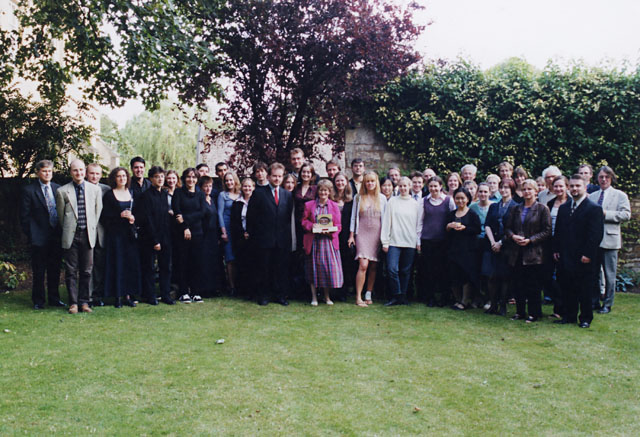
| CSAD Newsletter 9, Winter 2002 |
In July last year an International Epigraphy Summer School was organised by the Centre for the Study of Ancient Documents in partnership with the British Epigraphy Society. The School ran from 2nd July to 12th July and was based around facilities made available by the Centre, the Ashmolean Museum and Christ Church.
This was the first time that such an event in Epigraphy had been organised in Oxford. Previous Epigraphy Summer Schools, in 1984 and 1990, were hosted by the Institute of Classical Studies in London. The 1997 Oxford International Summer School in Papyrology provided a model and important insights for the organisers, Drs. Alison Cooley and Graham Oliver, into how such a School should be run.

Participants in the 2001 International Summer School in Greek and Latin Epigraphy relaxing in Christ Church Gardens before the Summer School Dinner
There was an enthusiastic response to initial advertisements for the Epigraphy Summer School. 80 preliminary enquiries eventually yielded 60 applications. There was a strong international flavour among the applicants. 47 applications were received from students outside Oxford. Of these 47, 22 were accepted. Financial support for the Summer School was considerable. There were three main sponsors: the Faculty of Literae Humaniores, the David Lewis Fund, and the British Epigraphy Society. The latter provided bursaries for three Studentships, one for a student from a UK University, and two for students from Eastern Europe (Poland and Serbia).
The students from outside Oxford were accommodated by Christ Church which proved to be very popular and gave the students something of the Oxford experience - by all accounts a good thing. The location of the Summer School at the Centre for the Study of Ancient Documents proved to be a valuable asset for participating students. The squeeze room was heavily used, as were the available books and photocopier, the computer room and the internet.
Students were arranged, working in pairs, using inscriptions in the Ashmolean Museum collection, which Michael Vickers and Mark Norman had re-organised in the museum basement so as to be readily accessible for the Summer School, and the CSAD collection of squeezes and photographs; additional study material for Latin epigraphy was selected by Alison Cooley and Michael Crawford. The students had regular opportunities to discuss their material with the course organisers and a triumvirate of course instructors who generously gave their time (Thomas Corsten, Charles Crowther, and Michael Crawford). To begin with, students were given instruction in the various elements of how to prepare an epigraphical publication. Charles Crowther and Thomas Corsten taught the students how to make squeezes and describe stones, and a wide range of seminars and workshops given by experts on more specific topics and themes was offered. Scholars from other institutions such as UCL and the British Museum were generous with their time and provided expertise to complement that of the local team.
"Hands-on" experience was provided through the availability of pottery and coin examples presented by Michael Vickers of the Ashmolean, Andy Meadows and Jonathan Williams of the British Museum and Chris Howgego and Henry Kim from the Heberden Coin Room. Alan Bowman illustrated his talk on the writing tablets with some examples from Vindolanda. William Stenhouse of UCL not only illuminated the problems of working from epigraphic manuscripts in a workshop session, but had also worked closely with the Bodleian Library in selecting manuscripts for a special display (which continued into the Triennial Conference) and in producing an explanatory leaflet to accompany it.
Four public lectures were organised on the broader themes of epigraphy and history to accompany the Summer School teaching programme. John Davies (Greek Epigraphy), Stephen Mitchell (East Roman Epigraphy), Michael Crawford (Roman Epigraphy) and Charlotte Roueché (Late Antique Epigraphy) all spoke to large audiences in the Ashmolean's Headley Lecture theatre.
At the end of the programme each student pair presented its findings to the Summer School participants in the Headley Lecture theatre. All those who had taken part in the Summer School were then invited to dine in Christ Church on the final evening, where they were treated to an after-dinner talk by Michael Ballance on his recollections of fieldwork in Asia Minor and memories of working with W.M. Calder.
The Summer School could not have been run without the generosity of the academics from inside and outside Oxford who participated in the programme. The organisers thank both them and Fergus Millar and Robert Parker who respectively welcomed and said farewell to the students.
The programme for the Summer School was intensive and packed full of experts and topics both broad and specific in subject matter. The students who participated in the programme were given instruction in the practical aspects of epigraphy and the theory and practice of publishing inscriptions. From all the reports that have filtered back to the organisers, the students found the programme both beneficial and enjoyable and at least one student is using the course as a formal accreditation in continuing on to an intermediate epigraphy course at her home university. Above all, the students also appreciated meeting such a broad cross-section of their peers from around the world, and all the academics who participated in the course similarly benefited from the stimulating atmosphere generated by this new generation of scholars.
Alison Cooley
Graham Oliver
Home | What's New | Events | Images | Links
| Created on |